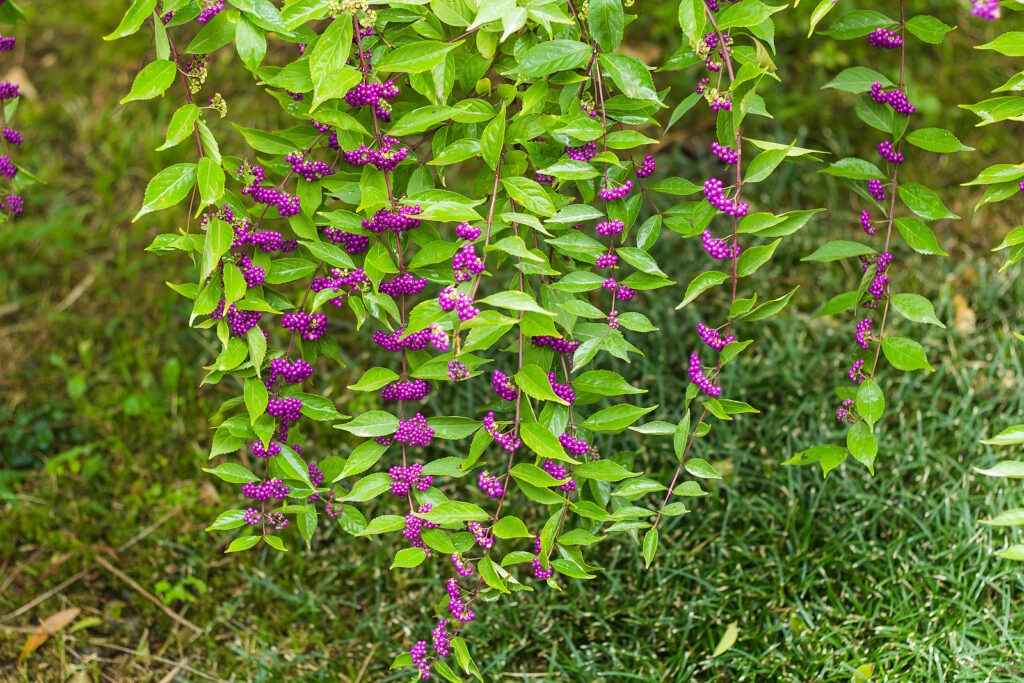Callicarpa — commonly called beautyberry — is a graceful shrub with arching branches. Callicarpa bears small lilac or pink flowers in summer that are followed by tight clusters of small, round violet or purple fruits that remain on the plant for several weeks after leaves fall in autumn and winter. As the common name suggest, Callicarpa is grown more for its beautiful berries than for its flowers.
There are two commonly planted varieties or Callicarpa. Callicarpa americana or American beautyberry grows upright from 4 to 8 feet tall and bears clusters of magenta berries in autumn. American beautyberry has a sprawling arching form. Callicarpa dichotoma or Chinese beautyberry grow 3 to 4 feet tall and bears clusters of purple berries with yellow foliage in autumn.
Callicarps can be used as specimens or in mass plantings or shrubs borders. Their sprawling, arching form makes them a poor choice for fomral gardens. In cold-winter regions, Callicarpa will die back to the ground in winter, but will grow back from its roots the following spring.
Callicarpa is a genus of about 140 specimens of evergreen and deciduous shrubs and treesd from woodland and in mainly tropical and subtropical regions.

Get to know Callicarpa
- Plant type: Deciduous shrub
- Growing zones and range: Zones 3-9
- Hardiness: Hardy to Zone 3; plants die back to the ground in cold-winter regions
- Height and width: 4 to 6 feet tall and nearly as wide depending on the variety; arching stems
- Flowers: Cymes or panicles of numerous, tiny white, pink, red, or purple flowers
- Bloom time: Summer
- Fruit: Fruit follows flowers; clusters of small, spherical, highly colorful bee-like fruits to 1/8 inch in diamters.
- Uses: Plant in groups in shrub borders or woodland gardens; use as specimen.
- Common name: Beautyberry
- Botanical name: Callicarpa
- Family name: Lamiaceae
- Origin: China, Taiwan, Japan
Where to plant Callicarpa
- Plant Callicarpa in full sun or light shade.
- Plant Callicarpa in well-drained, humus-rich soil.
- Callicarpa prefers a sheltered location; it is shade tolerant.

When to plant Callicarpa
- Set outdoors container-grown plants outdoors in spring or in fall in mild-winter regions.
- Sow seeds in spring.
- Start softwood cuttings in summer.
Planting and spacing Callicarpa
- Sow seeds 1/8 to ¼ inch deep in six-packs or flats filled with sterile seed-staring mix or polling soil. Sow seed outdoors in evenly prepared soil
- Space plants 3 to 8 feet (.9-2.4m) apart depending on the variety.
How to water and feed Callicarpa
- Keep the soil evenly moist for best growth; water Callicarpa sparingly in winter.
- Fertilize Callicarpa with a balanced liquid fertilizer montly.
Callicarpa care
- Cut Callicarpa back in spring, leaving only 4 to 6 inches of stem. Plants will resprout the following spring and growth will be vigorous and floweing and fruiting abundant.
- Callicarpa bears flowers and berries on the current season’s growth
- Callicarpa is susceptible to scale, black mildew, dieback, leaf scorch, and fungal leaf spots.

Callicarpa propagation
- Callicarpa is propagated by semi-ripe cuttings with bottom heat in summer.
- Callicarpa can be propagaged by ground layering mature branches.
- Callicarpa can be started from seed ub a cold frame in autumn or spring.
Callicarpa varieties to grow
- Callicarpa bodinieri, Bodinier beautyberry, native to China; grows to 6 feet tall or more and about as wide; willowlike leaves turn pini or orange to pure in fall; C. b. giraldii ‘Profusion’ is a heavy fruiting cultivar.
- C. dichotoma, purple beautyberry. Native to China, Korea, and Japan; grow to 4 feet tall and wide; slender branches sweep to the ground; finer features thatn C. bodinieri; fruits of C.d. albifructus are wite.; Early Amethyst’ fruit ripens brigh purple.
- C. japonica, Japanese beautyberry, native to China, Taiwan, and Japan; grows to 5 feet tall and wide; deep reddish-opurple fall foliage; cultivar ‘Leucocarpa’ bears white fruit.















